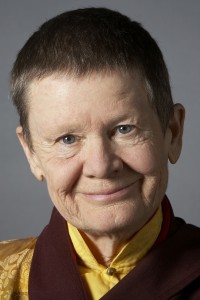Monday
Dharma TeachingsThe Threefold Purity
by Ani Pema Chodron
“To begin with, just give up any expectations of yourself. That’s a simple good instruction for how to do Buddhist meditation.”
Buddhist meditation is about dissolving our fixation on ourselves, on the process of meditating, and on any result we might gain from it. Through meditation, we begin to get the hang of living with a non-grasping attitude.
When you sit down to meditate, you can bring to your practice the notion of the threefold purity: not being caught up with ideas about yourself, not being caught up with ideas about the practice, and not being caught up with ideas about the result.
For example, if you’re new at it, you might take a certain pride in being a meditator. You come back from a retreat and your friends say, “Where were you?” and you say, “Oh, I was just meditating for ten days in a monastery on Cape Breton Island. We kept silence most of the time and we meditated many, many hours every day.” You have this feeling, “Wow! Are they going to be impressed.” Perhaps in other situations you feel a little embarrassed. If your parents ask you where you were, you might say, “Oh, I just went on a little trip to Cape Breton.”
To begin with, just give up any expectations of yourself. That’s a simple good instruction for how to meditate. Liberate yourself from any sort of idea of how you’re supposed to be, and just sit. Then remember this instruction occasionally during the meditation period, because you’re going to do a lot of talking to yourself about how right or how wrong you are.
Instead of holding on to a limited identity of yourself, do your best to observe yourself minute after minute. Observe what’s happening. You’ll keep freezing it by fixating on it, because you do have an idea of who you are; we all have an idea of who we are. But if you’ll just observe instead of fixating, the meditation itself will begin to shake that identity up a lot. You’ll begin to have doubt about being just one way; you’ll see that who you are and how you are keep changing.
That’s the first quality of threefold purity. Traditionally it’s stated as “no self.” What it points to is giving up expectations of being any particular way. Buddhist meditation is the perfect vehicle for seeing how you keep changing, changing, changing. Thoughts keep changing. Emotions keep changing. They say that advanced meditators can even see molecules changing. (Personally I’ve never had this experience.)
The second guideline of the threefold purity is “No meditation.” Don’t make your meditation a project or a special event; don’t bring into it an attitude of great seriousness and solemnity. For that matter, have no concept of your meditation at all, no religiosity. Don’t hold any notions about it, not even, “Oh, meditation is meant to be completely natural; you just sit down, relax the mind, and be cool.”
So you think, “That’s the meditation. I’m supposed to observe and let go. But I can’t observe and I can’t let go, and my meditation is a mess. On the other hand, I did observe a little bit, and that’s good. If I have a chance to tell my meditation instructor about this, she’ll be pleased.” We have a habitual tendency to solidify, but remember these instructions: no Expectations. It is as it is. You don’t have to add something extra.
The third quality of threefold purity is “No result.” Give up all hope of fruition. Practice without hope of anything beyond right now. That’s all there is; there’s no later. Being on the spot is the only way any transformation of your being occurs. If you practice with hope and fear, if you practice in order to become what you think you should be — even a calmer, more loving, more compassionate person — you’re just setting yourself up for disappointment. You can’t get there from here. Being fully here for each moment — that’s the point, from now until you die.
 After you’ve meditated, if you notice something that feels like a result — for example, your mind feels rested, or you feel completely one-pointed, or you feel a lot of compassion or kindness — simply observe it and let it go. Trungpa Rinpoche often used the word “disown.” It’s not that there’s anything wrong with results. But when we cling to results, they’re of no use at all. One of the mahamudra texts says, “Even the qualities of clarity, non-dwelling, and bliss are obstacles if you cling to them.”
After you’ve meditated, if you notice something that feels like a result — for example, your mind feels rested, or you feel completely one-pointed, or you feel a lot of compassion or kindness — simply observe it and let it go. Trungpa Rinpoche often used the word “disown.” It’s not that there’s anything wrong with results. But when we cling to results, they’re of no use at all. One of the mahamudra texts says, “Even the qualities of clarity, non-dwelling, and bliss are obstacles if you cling to them.”
So that’s threefold purity. It provides good directions for practicing meditation — or any other activity, for that matter. Have no expectation about who you are — the generous one or the mean one or whoever — no expectation of your activity or process, no expectation of fruition. This is how we go from living by concept, freezing ourselves in time and space, to relaxing into the fluid spaciousness with which we were born.
~~
Pema Chodron is the director of Gampo Abbey in Cape Breton, Nova Scotia, and author of The Wisdom of No Escape, Start Where You Are and When Things Fall Apart: Heart Advice for Difficult Times. Learn more at: pemachodronfoundation.org
article excerpted from “The Threefold Purity”, Pema Chodron, Shambhala Sun, May 1998.





